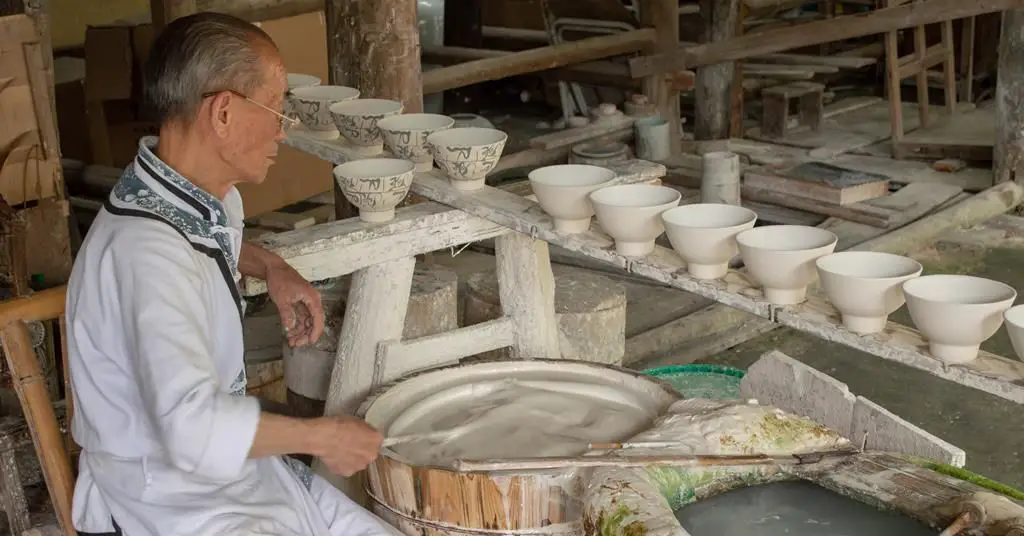How Was Porcelain Originally Made?
Porcelain is a ceramic material made by firing materials like kaolin, quartz and feldspar at high temperatures. It is known for its bright white color, hardness, durability, and delicate translucency. Porcelain differs from other pottery wares due to its high firing temperature, which results in low porosity making it non-absorbent and resonant. Porcelain became highly prized by nobility and royalty across cultures for its refined beauty and rarity. It became known as ‘white gold’ and a symbol of purity and refinement.
Origins in China
Porcelain originated in China during the Tang Dynasty around the 7th century AD. The earliest Chinese porcelains were developed in the provinces of Zhejiang and Hebei near the Yangtze River where clay deposits ideal for porcelain production were found. According to historical records, Chinese potters began experimenting with a high-fired ceramic glaze which resulted in a thin, translucent ceramic material that came to be known as porcelain.
Porcelain was greatly prized in ancient China and production techniques were closely guarded secrets. Chinese porcelain developed further during the Song Dynasty and by the Ming Dynasty, Chinese kilns were producing fine porcelain wares prized across Asia and Europe. The earliest Chinese porcelain featured monochrome glazes in cobalt blue, copper red or celadon green. By the 14th century, innovative decoration techniques like underglaze painting and overglaze enamels were developed.
Porcelain production centered around the city of Jingdezhen which became known as the “porcelain capital.” Jingdezhen had access to kaolin and petuntse, the essential raw materials for making porcelain. Using a special recipe that combined these ingredients in the right proportions was key to producing the translucent porcelain for which China became renowned. Chinese porcelain was traded extensively via land and sea routes like the Silk Road and Maritime Silk Road.

Ingredients
Porcelain is made from a combination of ingredients including kaolin clay, pottery stone, and quartz. Kaolin clay, also known as China clay, is the primary ingredient used to make porcelain. This type of clay contains the mineral kaolinite and forms when granite weathers over time. Kaolin clay is white in color when pure and has a fine, soft texture. It is essential for giving porcelain its translucency. Pottery stone, also called petuntse, provides the feldspar and quartz content in porcelain. Feldspar acts as a flux, lowering the vitrifying temperature of porcelain. Quartz gives strength and stability to the material. The combination of kaolin clay, pottery stone, and quartz is ground into a fine powder and mixed with water to form the porcelain paste.
According to inf.news, ancient Chinese porcelain used natural mineral pigments and plant dyes for decorative coloring.
Firing Process
Porcelain was fired at very high temperatures between 1,200 to 1,400 degrees Celsius in wood-burning or coal-burning kilns. Achieving these high temperatures was crucial to create the translucent, white aesthetic that porcelain is known for. The raw materials and clay body had to become fully vitrified and fuse together through this intense heat.
Firing took place in large dragon or bottle-shaped kilns constructed from fire bricks. The long shape allowed workers to easily load and remove pieces for continuous firing operations. Multiple firings were done, with the pieces first “biscuit fired” at around 1,000°C to harden them before applying glazes. The final glaze firing occurred at even higher temperatures exceeding 1,300°C.
Controlling the high temperatures was an intricate process. Kilns had multiple small firebox openings where workers could regulate airflow and heat. The intense heat also caused pieces to deform, requiring careful stacking and supports. Porcelain’s high glass content meant it could withstand rapid heating and cooling needed to achieve the flawless white translucent appearance.
Firing technology and control greatly improved over centuries of porcelain production. Better clay purification, kiln design, and pyrometric cones for measuring heat allowed potters to produce porcelain with stunning brilliance and whiteness unmatched anywhere else in the world. The extreme heat of the firing was crucial to develop the trademark qualities of Chinese porcelain.
(Source: https://up32photography.com/88-Ancient-Old-Chinese-Ru-Kiln-Porcelain-Phoenix-WUFBRkULGRpCRwcG)
Glazing
Once the porcelain pieces were shaped, they were coated with a glaze to produce the glossy, glass-like finish that porcelain is known for. According to Wikipedia, glazes generally contain silica as the main glass former, along with various metal oxides that provide color and effects.
The early Chinese porcelain glazes were made from ground, pre-fired pottery stones along with materials like limestone, quartz, and ash. The ingredients were mixed with water to create a slurry that was brushed or poured onto the biscuit porcelain before firing. The glaze melted during firing to produce the desired surface finish.
Applying the right glaze was an important step, as it transformed the porous biscuit into an impermeable final product with a beautiful sheen. The glaze also made the porcelain less prone to staining and gave it a hygienic surface for serving food and drink.
Molding Methods
Porcelain was shaped in several ways during its early history in China. One common method was hand molding, where artisans would shape the porcelain directly using their hands, tools and fingers. This allowed them to create one-of-a-kind pieces that were not restricted to a specific shape or design.
Another technique was to use molds, often made of plaster or clay. The porcelain would be pressed into the mold while still wet, allowing it to take on a standardized and reproducible form like bowls, vases or plates once fired. Molds enabled mass production but limited uniqueness and creativity in the final product.
Wheel throwing was also sometimes used, where the wet porcelain would be placed on a rotating pottery wheel and shaped by the momentum of the spinning and hands of the artisan. This allowed symmetrical round shapes to be easily formed. While not as common as hand molding or plaster molds, wheel throwing did provide another option for early porcelain production.
These three techniques – hand molding, plaster molds, and wheel throwing – were the primary methods used historically to shape porcelain before firing. The chosen technique impacted the ultimate form and design of the final porcelain pieces produced.[1]
Decoration
Porcelain decoration features intricate and elaborate painted, gilded, or engraved designs that showcase the fine craftsmanship of the artisans. Common designs include landscapes, flowers, birds, dragons, and auspicious motifs associated with prosperity and good fortune. Artists used fine tipped brushes and mineral based pigments to meticulously paint landscapes featuring towering mountains, cascading waterfalls, quaint pavilions, and solitary scholars immersed in nature (Source). The most complex multicolor designs required multiple firings at different temperatures to fix the pigments.
Gilding was applied by dusting gold powder onto a tacky glaze before firing, allowing the gold to fuse into the glaze surface. Engraving involved carving fine line designs into the porcelain body which highlighted the white porcelain canvas. The wide range of possible decorative techniques allowed artists to showcase incredible creativity within the confines of strict symmetry.
Trade and Spread
Chinese porcelain was highly prized and traded extensively along the Silk Road starting in the 14th century. Fine porcelain was exported westward to Europe and the Middle East. According to THE PINK FAMILY: CHINA AND THE WEST 7, the spread of Chinese porcelain went hand in hand with the diffusion of tea in England. Porcelain was an important facilitator and status symbol as tea drinking gained popularity among the aristocracy.
Porcelain also spread east and south to nations like Japan, Korea, and throughout Southeast Asia. As noted in Cultural Interchange Between Guangzhou and Southeast Asia, the motifs and styles of Chinese porcelain influenced ceramics produced locally in regions like Vietnam and Thailand. Chinese trade ceramics were also highly valued.
Innovations
The Chinese porcelain-making process saw many innovations and improvements over the centuries. The ingredients and production methods evolved through experimentation and technical advances.
One key area of innovation was in the clay mixtures used. As explained on the Phoenix Art Museum’s blog, early porcelain often contained small flecks of quartz that created cavities and weaknesses.1 However, porcelain clay recipes improved over time, enabling thinner, lighter, and more translucent wares.
There were also advances in porcelain glaze recipes. For example, celadon glazes were developed during the Song Dynasty, yielding a prized jade-green color.2 Later, striking cobalt blue pigments emerged as a signature of Ming Dynasty porcelains.
Kiln designs also evolved to reach higher temperatures and better distribute heat. This enabled firing of larger, thinner pieces with fewer defects. By the 12th century, egg-shaped kilns called Longquan kilns allowed firing at very high temperatures.
Through centuries of trial and error, Chinese potters mastered the creation of porcelain, devising optimal clay mixtures, glazes, and firing methods. The resulting delicate, high-fired ceramics fascinated people across the globe.
Conclusion
In summary, porcelain originated in China over a thousand years ago during the Tang dynasty. Its unique translucent quality, durability and artistic possibilities led to great demand and production over the centuries. Porcelain is made by firing a mixture of kaolin clay and other ingredients like quartz and feldspar at very high temperatures between 1250-1400 degrees Celsius. The porcelain clay requires careful preparation, molding, glazing and decorating to create the final pieces. Porcelain became an important export along the Silk Road trade routes to Europe and the Middle East. Chinese porcelain influenced ceramic traditions around the world over many centuries. While the formula and production methods were a closely guarded secret for centuries, innovations in materials science and manufacturing processes have allowed porcelain to spread globally today.


